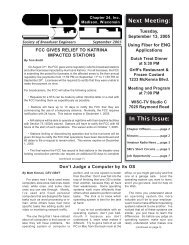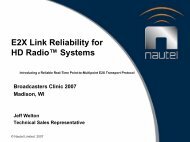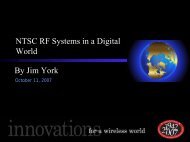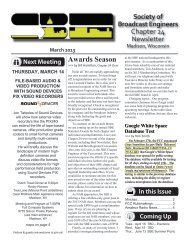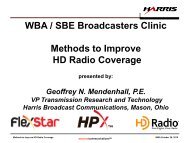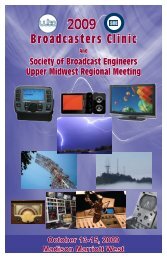FCC Method of Moments - SBE Chapter 24
FCC Method of Moments - SBE Chapter 24
FCC Method of Moments - SBE Chapter 24
You also want an ePaper? Increase the reach of your titles
YUMPU automatically turns print PDFs into web optimized ePapers that Google loves.
<strong>FCC</strong> <strong>Method</strong> <strong>of</strong> <strong>Moments</strong><br />
Licensing AM<br />
Directional Antenna<br />
Systems
The Task<br />
Comply with Construction Permit<br />
– Certify correct antenna location<br />
– Certify compliant pattern shape<br />
– Certify compliant pattern size<br />
Prepare <strong>FCC</strong> “302”<br />
Propose Verifiable Operating Parameters
Classic AM “Pro<strong>of</strong>”<br />
Construction Permit Requires<br />
– Un-attenuated Inverse Field<br />
Field Measurements Provide<br />
– Attenuated Inverse Field<br />
Need to Determine Ground Conductivity<br />
– Build and measure a reference antenna
Classic AM “Pro<strong>of</strong>”<br />
Establish Pattern Shape and Size<br />
– Measure directional antenna fields<br />
– Apply ground conductivity correction<br />
– Compare results to construction permit<br />
– Adjust phasor controls<br />
– Repeat as necessary…<br />
– Perhaps hundreds <strong>of</strong> field measurements<br />
A Time (and Money) Consuming Process
Classic “AM “ Pro<strong>of</strong><br />
Pattern Shape<br />
– A function <strong>of</strong> individual tower contributions<br />
– Antenna monitor and sampling system<br />
Antenna Monitor Parameters<br />
– A “snapshot” on the last day <strong>of</strong> adjustment<br />
– For reference, absolute value means little<br />
– Filed with <strong>FCC</strong> “302” – License Parameters
Classic AM “Pro<strong>of</strong>”<br />
Long Term Maintenance<br />
– “Periodic” License Parameter Readings<br />
– “Periodic” Monitor Point readings<br />
Future Antenna System Changes<br />
– More field measurements<br />
– Reference original ground conductivity<br />
– More repeat as necessary…
Could This<br />
Cumbersome Process<br />
be Improved?
<strong>FCC</strong> <strong>Method</strong> <strong>of</strong> <strong>Moments</strong><br />
PRM 08-228 Second Report and Order<br />
– Originally <strong>FCC</strong> MM 93-177<br />
– Originally Proposed in 1991<br />
Hatfield and Dawson<br />
duTreil, Lundin & Rackley<br />
Lahm, Suffa & Cavell<br />
M<strong>of</strong>fet, Larson & Johnson<br />
Silliman & Silliman<br />
– Available for Use in Filings Early in 2009
“<strong>Method</strong> <strong>of</strong> <strong>Moments</strong>”<br />
Applicable to Engineering Problems<br />
– Acoustics, Fluids, Mechanics<br />
– Electromagnetics<br />
Also Known as:<br />
– Boundary Element <strong>Method</strong><br />
– Finite Element <strong>Method</strong><br />
– Finite Difference <strong>Method</strong>
“<strong>Method</strong> <strong>of</strong> <strong>Moments</strong>”<br />
From “Wikipedia”:<br />
– a numerical computational method <strong>of</strong> solving<br />
linear partial differential equations which have<br />
been formulated as integral equations (i.e. in<br />
boundary integral form).<br />
– In electromagnetics, the more traditional term<br />
"method <strong>of</strong> moments" is <strong>of</strong>ten, though not<br />
always, synonymous with "boundary element<br />
method"
“<strong>Method</strong> <strong>of</strong> <strong>Moments</strong>”<br />
In Plain English:<br />
– Take a large complicated problem<br />
– Cut it up into small, simpler pieces<br />
– Solve the pieces (perhaps simultaneously)<br />
– Recombine the solutions<br />
The Numerical Electromagnetics Code<br />
– Lawrence Livermore National Laboratory
“<strong>Method</strong> <strong>of</strong> <strong>Moments</strong>”<br />
Continuous Current<br />
Segmented Current
“<strong>Method</strong> <strong>of</strong> <strong>Moments</strong>”<br />
NEC Modeled Antenna<br />
¼ Wave Vertical<br />
“Perfect” ground<br />
10 Segments<br />
Color indicates currents
“<strong>Method</strong> <strong>of</strong> <strong>Moments</strong>”<br />
NEC Modeled Antenna<br />
“Wire Frame” patterns<br />
Polar plots<br />
Antenna gain<br />
Drive Point Impedance<br />
about 36 j0 ohms
“<strong>Method</strong> <strong>of</strong> <strong>Moments</strong>”<br />
NEC Modeled Antenna<br />
5/8 Wave Vertical<br />
Note Skywave Lobes<br />
Drive Point Impedance<br />
about 205 –j613 ohms
Back to “The Task”<br />
Consider a Non-Directional “302”<br />
– Determine Location: USGS Map<br />
– Determine Pattern Shape<br />
Defined by geometry in horizontal plane<br />
Defined by formula in vertical plane<br />
f<br />
( )<br />
<br />
cos( Gsin<br />
)<br />
cosG<br />
(1 cosG)cos<br />
(<strong>FCC</strong> Rules 73.160)
)cos<br />
cos<br />
(1<br />
cos<br />
)<br />
sin<br />
cos(<br />
)<br />
(<br />
G<br />
G<br />
G<br />
f<br />
<br />
<br />
<br />
<br />
<br />
<br />
)cos<br />
cos<br />
(1<br />
cos<br />
)<br />
sin<br />
cos(<br />
)<br />
(<br />
G<br />
G<br />
G<br />
f<br />
<br />
<br />
<br />
<br />
<br />
<br />
)cos<br />
cos<br />
(1<br />
cos<br />
)<br />
sin<br />
cos(<br />
)<br />
(<br />
G<br />
G<br />
G<br />
f<br />
<br />
<br />
<br />
<br />
<br />
<br />
)cos<br />
cos<br />
(1<br />
cos<br />
)<br />
sin<br />
cos(<br />
)<br />
(<br />
G<br />
G<br />
G<br />
f<br />
<br />
<br />
<br />
<br />
<br />
<br />
)cos<br />
cos<br />
(1<br />
cos<br />
)<br />
sin<br />
cos(<br />
)<br />
(<br />
G<br />
G<br />
G<br />
f<br />
<br />
<br />
<br />
<br />
<br />
<br />
)cos<br />
cos<br />
(1<br />
cos<br />
)<br />
sin<br />
cos(<br />
)<br />
(<br />
G<br />
G<br />
G<br />
f<br />
<br />
<br />
<br />
<br />
<br />
<br />
)cos<br />
cos<br />
(1<br />
cos<br />
)<br />
sin<br />
cos(<br />
)<br />
(<br />
G<br />
G<br />
G<br />
f
NDA Pattern Size<br />
Un-attenuated Field (specified in mV/m)<br />
– Difficult to directly measure<br />
Proportional to Power (in Watts)<br />
– Difficult to directly measure<br />
Proportional to Base Current (in Amperes)<br />
– Easily measured if base impedance is known
NDA Base Impedance<br />
Determined by:<br />
– Tower height, cross-section, material<br />
– Base Insulator, lighting chokes<br />
– Isocouplers, stray reactance, etc.<br />
Measure Impedance<br />
– Not expected to change under power<br />
– Required base current can be calculated
NDA <strong>FCC</strong> “302”<br />
Location – coordinates from USGS Map<br />
Pattern Shape – geometry and formula<br />
Pattern Size – calculated base current<br />
We have obtained the required technical<br />
information to prepare the license<br />
application without ever actually turning on<br />
the transmitter.
Back to “The Task”<br />
<strong>FCC</strong> <strong>Method</strong> <strong>of</strong> <strong>Moments</strong> for DA’s<br />
– Modeling the directional array<br />
– Verifying the mathematical model<br />
– Establishing operating parameters<br />
– Sampling system requirements<br />
– Long term maintenance<br />
– Additional <strong>FCC</strong> requirements
Modeling<br />
NEC Model<br />
– Mathematical description <strong>of</strong> array<br />
– Excite each tower, “float” all others<br />
– Create a tower array impedance matrix<br />
Physical Array<br />
– Measure each tower, “float” all others<br />
– Characterize any extra “stuff”<br />
“Massage” the Model
Example<br />
GEOMETRY<br />
Wire coordinates in degrees; other dimensions in meters<br />
Environment: perfect ground<br />
wire caps Distance Angle Z radius segs<br />
1 none 0 0 0 .29 10<br />
0 0 84.6<br />
2 none 181.2 120.2 0 .29 10<br />
181.2 120.2 84.6<br />
3 none 366.4 116.6 0 .29 10<br />
366.4 116.6 84.6<br />
4 none 123.8 213.6 0 .29 10<br />
123.8 213.6 84.6<br />
5 none 201.7 144.9 0 .29 10<br />
201.7 144.9 84.6<br />
6 none 375.6 130.1 0 .29 10<br />
375.6 130.1 84.6<br />
7 none 90. 176.7 0 .29 10<br />
90. 176.7 84.6
Example
Example<br />
IMPEDANCE<br />
normalization = 50.<br />
freq resist react imped phase VSWR S11 S12<br />
(KHz) (ohms) (ohms) (ohms) (deg) dB dB<br />
source = 1; node 1, sector 1<br />
1,180. 33.353 -7.1002 34.101 348. 1.5521 -13.297 -.20817<br />
Model Impedance for all towers: 33.4 –j7.1 Ohms<br />
Measured Impedance for tower 1: 39.1 +j60.2 Ohms<br />
Not Acceptable
Verifying the Model<br />
Other “Stuff” <<br />
> Tower<br />
Feedline Inductance - Xls<br />
Stray Capacitance - Xcsc<br />
Base Insulator - Xcb<br />
ATU<br />
Msmt.<br />
Point<br />
Xl s<br />
Xc sc<br />
Xc b
Verifying the Model<br />
With Series Inductance<br />
Zatu<br />
<br />
Rb<br />
<br />
jXb<br />
jXls<br />
With Shunt Capacitance<br />
Ratu<br />
Xatu<br />
<br />
<br />
<br />
2<br />
Rb Xcs<br />
2 / Rb Xb<br />
Xcs<br />
<br />
2 2<br />
jXcs<br />
Rb Xb Xb<br />
Xcs<br />
<br />
Rb<br />
2<br />
<br />
<br />
Xb <br />
Xcs<br />
<br />
2<br />
<br />
2
Verifying the Model<br />
Change Velocity <strong>of</strong> Propagation<br />
Slower velocity = taller tower<br />
Measured Impedance for tower 1<br />
39.1 +j60.2 Ohms<br />
Model Impedance for Vp <strong>of</strong> 95.3% (105.2% height)<br />
39.1 +j13.8 Ohms<br />
Resistance is now Acceptable
Example<br />
GEOMETRY<br />
Wire coordinates in degrees; other dimensions in meters<br />
Environment: perfect ground<br />
wire caps Distance Angle Z radius segs<br />
1 none 0 0 0 .29 10<br />
0 0 88.8<br />
2 none 181.2 120.2 0 .29 10<br />
181.2 120.2 88.5<br />
3 none 366.4 116.6 0 .29 10<br />
366.4 116.6 88.2<br />
4 none 123.8 213.6 0 .29 10<br />
123.8 213.6 88.<br />
5 none 201.7 144.9 0 .29 10<br />
201.7 144.9 88.6<br />
6 none 375.6 130.1 0 .29 10<br />
375.6 130.1 88.2<br />
7 none 90. 176.7 0 .29 10<br />
90. 176.7 90.2
Example<br />
Number <strong>of</strong> wires = 7<br />
current nodes = 70<br />
minimum<br />
maximum<br />
Individual wires wire value wire value<br />
segment length 4 8.8 7 9.02<br />
radius 1 .29 1 .29<br />
ELECTRICAL DESCRIPTION<br />
Frequencies (KHz)<br />
frequency<br />
no. <strong>of</strong> segment length (wavelengths)<br />
no. lowest step steps minimum maximum<br />
1 1,180. 0 1 .0<strong>24</strong>4444 .0250556<br />
Sources<br />
source node sector magnitude phase type<br />
1 1 1 1. 0 voltage
Example<br />
Lumped loads<br />
resistance reactance inductance capacitance passive<br />
load node (ohms) (ohms) (mH) (uF) circuit<br />
1 1 0 0 0 0 0<br />
2 11 0 -10,000. 0 0 0<br />
3 21 0 -10,000. 0 0 0<br />
4 31 0 -10,000. 0 0 0<br />
5 41 0 -10,000. 0 0 0<br />
6 51 0 -10,000. 0 0 0<br />
7 61 0 -10,000. 0 0 0<br />
IMPEDANCE<br />
normalization = 50.<br />
freq resist react imped phase VSWR S11 S12<br />
(KHz) (ohms) (ohms) (ohms) (deg) dB dB<br />
source = 1; node 1, sector 1<br />
1,180. 39.052 13.775 41.41 19.4 1.4853 -14.187 -.16884
Example<br />
CURRENT rms<br />
Frequency = 1180 KHz<br />
Input power = .0113867 watts<br />
Efficiency = 100. %<br />
coordinates in degrees<br />
current mag phase real imaginary<br />
no. X Y Z (amps) (deg) (amps) (amps)<br />
GND 0 0 0 .0170758 340.6 .0161033 -5.68E-03<br />
2 0 0 8.88 .0170977 338.6 .0159227 -6.23E-03<br />
3 0 0 17.76 .0166592 337.4 .0153845 -6.39E-03<br />
4 0 0 26.64 .0158121 336.5 .014499 -6.31E-03<br />
5 0 0 35.52 .0145774 335.7 .0132834 -6.E-03<br />
6 0 0 44.4 .012979 335. .0117601 -5.49E-03<br />
7 0 0 53.28 .011045 334.3 9.96E-03 -4.78E-03<br />
8 0 0 62.16 8.8E-03 333.8 7.9E-03 -3.89E-03<br />
9 0 0 71.04 6.28E-03 333.2 5.61E-03 -2.83E-03<br />
10 0 0 79.92 3.46E-03 332.7 3.08E-03 -1.59E-03<br />
END 0 0 88.8 0 0 0 0
Verifying the Model<br />
Adjust Tower Impedance Matrix<br />
– “Massage” model to agree with values<br />
measured at the ATU output<br />
Adjust model height (velocity <strong>of</strong> propagation)<br />
Add lumped feed inductance (series)<br />
Compensate for base insulator capacitance<br />
– Repeat for each tower in array<br />
– An iterative process
<strong>FCC</strong> Requirements<br />
– Only arrays with series-fed elements<br />
– At least 1 segment per 10 degrees height<br />
– Modeled radii between 80% and 150% <strong>of</strong><br />
circle <strong>of</strong> circumference equal to sum <strong>of</strong> sides<br />
– Modeled height between 75% and 125% <strong>of</strong><br />
physical tower height
<strong>FCC</strong> Requirements<br />
– Tapered towers may be modeled as a series<br />
<strong>of</strong> stepped cylinders (wedding cake)<br />
– Actual tower spacings and orientation must be<br />
used in the model<br />
This needs to be confirmed by a surveyor<br />
– Lumped series inductance limited to 10 uH<br />
– Lumped shunt capacitance limited to 250 pF
<strong>FCC</strong> Requirements<br />
– Other base region components (lighting<br />
chokes, etc.) must be specifically measured<br />
and included in the model<br />
– Measured impedance matrix must agree with<br />
moment method model within +/- 2 ohms or<br />
+/- 4%, which ever is greater
Example<br />
Two turn lightning<br />
loops placed in tower<br />
feeds<br />
(all 7 towers)<br />
Loops measured<br />
between<br />
j33.9 and j46.6 Ohms<br />
(4.6 – 6.3 uH)
Example<br />
Tower Msd Msd<br />
Msd<br />
Feed Calc Model Model Model Model Model Model<br />
R X X X Height % <strong>of</strong> 84.6 R R % dev X X dev<br />
1 39.1 60.2 40.3 19.9 88.8 105.2 39.1 -0.12 13.8 -6.15<br />
2 39.8 61.0 44.5 16.5 88.5 104.9 39.8 -0.09 11.6 -4.89<br />
3 38.7 50.0 33.9 16.1 88.2 104.5 38.6 -0.20 9.8 -6.26<br />
4 37.6 45.8 34.8 11.0 88.0 104.3 37.6 -0.05 8.3 -2.67<br />
5 39.7 60.2 46.6 13.6 88.6 105.0 39.6 -0.17 12.0 -1.56<br />
6 38.7 43.2 38.1 5.1 88.2 104.5 38.7 0.03 10.0 4.92<br />
7 39.0 58.5 38.6 19.9 90.2 106.9 39.0 -0.12 20.9 0.94<br />
Model R’s now within 0.1 Ohm <strong>of</strong> measured R’s<br />
Model tower heights at 104% to 107% <strong>of</strong> actual<br />
Model lumped inductance less than 10 uH
Modeling<br />
Pattern Shape Defined by Formula<br />
n<br />
<br />
E( ,<br />
)<br />
k E f ( )<br />
S cos<br />
cos( )<br />
<br />
theo<br />
i1<br />
i<br />
The Sum <strong>of</strong> Individual Tower Fields<br />
– Field ratio and phase for each tower<br />
– Specified in construction permit<br />
i<br />
(<strong>FCC</strong> Rules 73.150)<br />
<br />
i<br />
i<br />
i
Modeling<br />
Measuring the Tower Field is Difficult<br />
– As with NDA, measure currents, however…<br />
Establishing Tower Drive Impedances<br />
in Directionals is Very Difficult<br />
Impedance is really “Volts-per-Ampere”<br />
– Tower drive impedance is a summation<br />
– Self-impedance plus other “volts-per-ampere”
Modeling<br />
Credit to Jerry Westburg:<br />
– “Matrix <strong>Method</strong> for Relating Base Current<br />
Ratios to Field Ratios <strong>of</strong> AM Directionals”<br />
– IEEE Trans. On Bcstg. V 35 #2, June, 1989<br />
Calculate Drive Impedances and Currents<br />
– Verified NEC mathematical model<br />
– Field ratios from construction permit
Example<br />
MEDIUM WAVE ARRAY SYNTHESIS FROM FIELD RATIOS<br />
Frequency = 1180 KHz<br />
field ratio<br />
tower magnitude phase (deg)<br />
1 1. 0<br />
7 .894 109.2<br />
VOLTAGES AND CURRENTS - rms<br />
source voltage<br />
current<br />
node magnitude phase (deg) magnitude phase (deg)<br />
1 1,730.9 40.8 27.9853 5.2<br />
61 419.553 128.1 26.2662 111.1<br />
Sum <strong>of</strong> square <strong>of</strong> source currents = 2,948.56<br />
Total power = 50,000. watts<br />
Normalize phase (111.1 – 5.2), Tower 7 Phase = +105.9°<br />
Ratio current (26.2662 / 27.9853), Tower 7 Ratio = 0.939
Example<br />
MEDIUM WAVE ARRAY SYNTHESIS FROM FIELD RATIOS<br />
field ratio<br />
tower magnitude phase (deg)<br />
1 .438 -6.9<br />
2 1. 0<br />
3 .523 16.7<br />
4 .418 64.9<br />
5 .99 99.5<br />
6 .549 122.<br />
VOLTAGES AND CURRENTS - rms<br />
source voltage<br />
current<br />
node magnitude phase (deg) magnitude phase (deg)<br />
1 <strong>24</strong>6.145 333.3 3.69944 .1<br />
11 415.6<strong>24</strong> 17.3 7.85442 5.5<br />
21 184.362 23.4 4.18681 21.5<br />
31 38.5047 339.6 3.44322 65.1<br />
41 56.0734 45.7 8.02852 100.<br />
51 13.22<strong>24</strong> 329.3 4.43341 121.8<br />
Sum <strong>of</strong> square <strong>of</strong> source currents = 378.234<br />
Total power = 5,000. watts
Example<br />
Day Pattern - 50 KW.<br />
Tower Theo. Theo. Model Model Model Model Ant. Mon. Ant. Mon.<br />
Field Phase R X Current Phase Ratio Phase<br />
(Ref) 1 1 0 50.323 35.981 27.9982 5.2 1.000 0.0<br />
7 0.894 109.2 15.269 4.6807 26.2882 111.1 0.939 105.9<br />
Night Pattern - 5 KW.<br />
Tower Theo. Theo. Model Model Model Model Ant. Mon. Ant. Mon.<br />
Field Phase R X Current Phase Ratio Phase<br />
1 0.438 -6.9 59.4<strong>24</strong> -31.339 3.69731 0.1 0.471 -5.4<br />
(Ref) 2 1 0 51.818 10.779 7.85258 5.5 1.000 0.0<br />
3 0.523 16.7 44.009 1.4782 4.18673 21.5 0.533 16.0<br />
4 0.418 64.9 0.8838 -11.147 3.44338 65.1 0.439 59.6<br />
5 0.99 99.5 4.0698 -5.6732 8.03095 100 1.023 94.5<br />
6 0.549 122 -2.6455 -1.3779 4.43277 121.8 0.564 116.3<br />
Operating Parameters Calculated!
Example<br />
C : \ D o c u m e n t s a n d S e t t i n g s \ Ow n e r\ D e s k t o p \ T e m p M B P ro \ K Y E S D a y A rra y 1 0 -0 6 -2 0 0 9 , 2 2 : 2 1 : 3 4<br />
Ge o g ra p h i c c o o rd i n a t e s : E -t h e t a m a g n i t u d e rm s , m v / m , e l e v a t i o n = 0 d e g re e s<br />
m i n i m u m = 0 , m a x i m u m = 3 , 4 2 0 . , d y n a m i c ra n g e = 3 , 4 1 9 . 1 , s c a l e = 1<br />
M a x i m u m g a i n : 3 , 4 1 9 . 1 rm s , m v / m a t 3 5 7 . d e g ; -3 d B b e a m w i d t h : t o 2 7 7 . 9 d e g re e s<br />
1 , 1 8 0 . K H z<br />
0<br />
330<br />
30<br />
300<br />
60<br />
270<br />
500 1000 1500 2000 2500 3000<br />
90<br />
<strong>24</strong>0<br />
120<br />
210<br />
150<br />
180<br />
CP pattern versus<br />
NEC generated pattern
Example<br />
C : \ D o c u m e n t s a n d S e t t i n g s \ Ow n e r\ D e s k t o p \ T e m p M B P ro \ K Y E S N i g h t A rra y 1 0 -0 6 -2 0 0 9 , 2 2 : 2 5 : 2 2<br />
Ge o g ra p h i c c o o rd i n a t e s : E -t h e t a m a g n i t u d e rm s , m v / m , e l e v a t i o n = 0 d e g re e s<br />
m i n i m u m = 0 , m a x i m u m = 1 , 8 6 0 . , d y n a m i c ra n g e = 1 , 8 5 6 . 4 6 , s c a l e = 1<br />
M a x i m u m g a i n : 1 , 8 5 6 . 5 rm s , m v / m a t 1 8 . d e g ; -3 d B b e a m w i d t h : 3 8 . 5 t o d e g re e s<br />
1 , 1 8 0 . K H z<br />
0<br />
330<br />
30<br />
300<br />
60<br />
270<br />
500 1000 1500<br />
90<br />
<strong>24</strong>0<br />
120<br />
210<br />
150<br />
180<br />
CP pattern versus<br />
NEC generated pattern
DA <strong>FCC</strong> “302”<br />
Location – from Surveyor<br />
Pattern Shape – <strong>Method</strong> <strong>of</strong> <strong>Moments</strong><br />
Pattern Size – calculated CP current<br />
We have obtained most <strong>of</strong> the required<br />
technical information to prepare the license<br />
application without turning on the transmitter.<br />
But, we still need to tune up the phasor…
Example<br />
Tune-up:<br />
– Day, 2 towers - about 4 hours<br />
– Night, 6 towers - about 4 days<br />
More fussing required at ATU’s<br />
Some very low tower drive impedances<br />
– Measurements to characterize the array<br />
– Time to “massage” the model
<strong>FCC</strong> Requirements<br />
Determining “Proper Adjustment”<br />
– Correlation <strong>of</strong> the <strong>Method</strong> <strong>of</strong> <strong>Moments</strong><br />
parameters and antenna monitor indications<br />
Ratio +/- 5%<br />
Phase +/- 3 degrees<br />
– Correlation <strong>of</strong> <strong>Method</strong> <strong>of</strong> <strong>Moments</strong> and<br />
measured matrix impedances<br />
Within +/- 2 ohms, +/- 4% for both<br />
resistance and reactance
Sampling System<br />
“Classic” Pro<strong>of</strong><br />
– Pattern adjusted by field measurements<br />
– Antenna parameters are a “snapshot”<br />
Values are a relative indication <strong>of</strong> operation<br />
<strong>Method</strong> <strong>of</strong> <strong>Moments</strong> Pro<strong>of</strong><br />
– Pattern adjusted by antenna parameters<br />
Values are an absolute indication <strong>of</strong> operation
Sampling System<br />
The Sampling System Must be Accurate<br />
– Verified equal phase shift in all lines<br />
– Verified equal impedance for all lines<br />
– Verified equal sample toroid characteristics<br />
– Verified accurate antenna monitor<br />
System Measurements<br />
– Network analyzer or impedance bridge
Sample Line Verification<br />
Open Circuit<br />
R F Generator<br />
Wideband<br />
Detector<br />
Line Open Circuit<br />
Tuneable RF source<br />
Oscilloscope<br />
GR 916AL Bridge<br />
R F Bridge
Sample Lines<br />
Verifying Length and Impedance<br />
– Find nearest sample line resonant frequency<br />
Open circuit line<br />
Shorts occur at odd multiples <strong>of</strong> ¼ wavelength<br />
Ratio frequencies for sample line length at carrier<br />
– Measure lines at + and – 1/8 wavelength<br />
Z<br />
<br />
<br />
<br />
<br />
R<br />
<br />
X<br />
<br />
<br />
<br />
2 2<br />
2 2<br />
0 <br />
<br />
<br />
<br />
4 4<br />
4 4<br />
R<br />
<br />
X
Example<br />
Sample line measurements with GR-916AL bridge<br />
Null measurements made with far line end OPEN<br />
Null #1 Null #2 Null #3 1180 KHz Offset Offset<br />
Tower 90 deg 270 deg 450 deg Length +45 deg -45 deg<br />
Khz. Khz. Khz. deg. Khz. Khz.<br />
1 318.0 961.0 1609.3 331.5 1121.2 800.8<br />
2 318.0 961.2 1609.6 331.5 1121.4 801.0<br />
3 318.0 961.2 1609.5 331.5 1121.4 801.0<br />
4 318.0 961.1 1609.6 331.5 1121.3 800.9<br />
5 318.0 961.1 1609.5 331.5 1121.3 800.9<br />
6 318.1 961.3 1609.9 331.4 1121.5 801.1<br />
7 318.0 961.1 1609.6 331.5 1121.3 800.9
Example<br />
Sample line measurements with GR-916AL bridge<br />
Null measurements made with far line end OPEN;<br />
Meas. Meas. Meas. Meas. Calc. Line and Toroid<br />
Tower R (+45) X (+45) R (-45) X (-45) line Z Meas. R Meas. X<br />
ohms ohms ohms ohms ohms ohms ohms<br />
1 5.6 48.1 4.4 -50.6 49.6 49.2 1.3<br />
2 5.6 48.1 4.3 -50.6 49.6 48.6 1.7<br />
3 5.7 48.1 4.3 -50.6 49.6 48.9 1.3<br />
4 5.6 48.1 4.3 -50.6 49.6 48.7 1.3<br />
5 5.7 48.1 4.3 -50.6 49.6 48.8 1.7<br />
6 5.6 48.1 4.3 -50.6 49.6 48.6 1.3<br />
7 5.7 48.1 4.4 -50.6 49.6 48.8 1.3
Sample System<br />
Verifying Toroids<br />
– Build a test fixture<br />
– Common RF current<br />
– Toroids closely spaced<br />
– Use antenna monitor for measurement<br />
Verifying Sample Loops<br />
– More complicated<br />
– <strong>FCC</strong> Rules 73.151, <strong>FCC</strong> 08-228
Toroid Verification<br />
Toroids<br />
R F Source<br />
Dummy Load<br />
Test Lines<br />
Antenna Monitor
Example<br />
Toroid Test Fixture<br />
– Always ground toroids!<br />
– Always terminate!<br />
Operate into Load<br />
Used Potomac 1900<br />
– Equal Length cables<br />
– 1.5 RF Volts minimum
<strong>FCC</strong> Requirements<br />
– Sample line lengths must agree within 1<br />
electrical degree<br />
– Sample line characteristic impedances must<br />
agree within 2 ohms<br />
– Toroids allowed for tower heights less than<br />
120 degrees or greater than 190 degrees
Field Measurements<br />
Some Field Measurements Still Required<br />
– On pattern minima and maxima<br />
– Three points per radial<br />
– Only reference measurements<br />
Not Monitor Points, No Regular Readings<br />
– However, these measurements (and some<br />
others) must be periodically repeated
Maintenance<br />
At Least Once Every <strong>24</strong> Months<br />
– Sampling system<br />
Recertify toroid performance<br />
– Common reference signal calibration<br />
Recertify sample line performance<br />
– Length and characteristic impedance<br />
– Repeat reference field measurements<br />
– Retain in Public Inspection File
The Decision<br />
<strong>Method</strong> <strong>of</strong> <strong>Moments</strong><br />
or<br />
“Classic” Pro<strong>of</strong>




